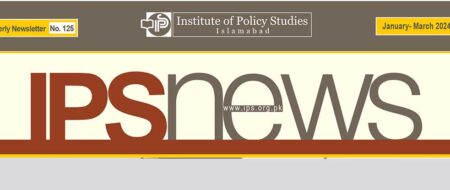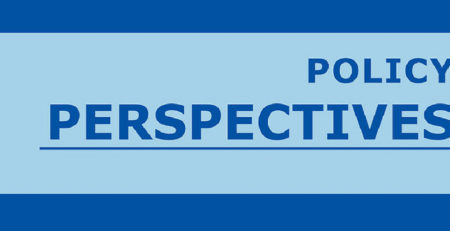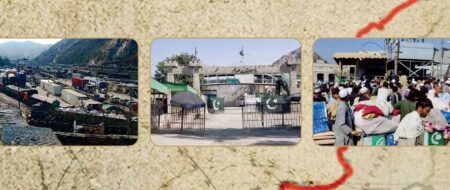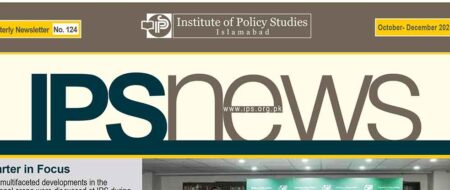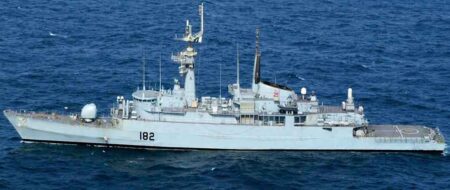Policy Perspectives (Vol 15, No. 1)
| Chief Editor: | Khalid Rahman |
| Volume: | 15 |
| Number: | 1 |
| Pages: | 153 |
| Retail Price (Pak): | PKR600 |
| Annual Subscription: | PKR1000 |
| Export Price: | $60 (per copy) |
| Annual International Subscription: | $120 |
About the Issue
The latest edition of peer-reviewed IPS’ flagship journal Policy Perspectives – disseminating the research carried out by IPS and its associates on diverse range of current and evolving topics – is out now and is widely available for the readers in Pakistan and abroad.
The issue combines deliberations upon important global theoretical debates as well as discourse on current regional and international matters of significance.
The first article ‘Indo-US Strategic Partnership: Implications for Pakistan’ explores that in the scheme of American grand strategy for the new world order, US and India have complementary economic and strategic security interests as the former desires to maintain her economic and military supremacy in the world. Pakistan cannot afford to remain oblivious to these developments and must revive her economy and achieve more national cohesion so as to offset the negative effects of Indo-US strategic convergence.
The second article ‘India and Pakistan: Outlining a Path towards Peace’ is a multidisciplinary analysis of the relationship between India and Pakistan, contending that much would be gained by Pakistan and India if normalization between the two could be achieved. The paper puts forth areas where there exist common interests and what they believe could be a path to peace between these nation-states.
The third piece ‘Developments in Indian Missile Program: Options for Pakistan’ maintains that with the induction of new weapon systems in South Asia, notably BMDs, the region would gradually become prone to risk of war especially due to unresolved disputes, notably Kashmir. Possibility of a nuclear exchange between India and Pakistan would keep the populace of this region hostage to the nuclear radiation effects around the globe.
The article ‘China-South Asia Communications under BRI: The CPEC Model’ maintains that the physical and functional aspects of the ‘Belt and Road Initiative (BRI)’ would naturally attract the m aximum attention of both friends and adversaries, thus an aggressive communication strategy advancing the spirit of BRI is a prerequisite to make the project a real success.
The piece ‘Maritime Politics in South Asia and Naval Compulsions of CPEC for Pakistan’ views that the development of sea-ports as part of BRI in general and Gwadar as part of CPEC in particular has provided a context to India to magnify its ‘concerns’ and aim for a renewed naval build-up. Islamabad needs to carefully evaluate its options and develop its strategic response accordingly, involving but not limited to continuous development of its naval capability and an even closer maritime cooperation with China.
The article ‘Human Security and Central Asian States’ opines that the lasting security and development cannot be obtained in the Central Asia unless and until various dimensions of human security become priority of the governments in the region. The improvement in this arena requires three level strategies: national, regional and international.
The next piece ‘Central Asia’s Place in Turkey’s Foreign Policy’ beholds that with the geopolitical developments in Ukraine and dramatic slowdown of the Russian economy, Turkey’s balancing act in Central Asia was seen as beneficial by Moscow. Moreover, after the failed military coup attempt in Turkey (July 2016), Russian and Turkish leadership have showed friendly overtures to each other which can strengthen their relations and both these players can play constructive role towards the development of Central Asia region.
The eighth article ‘China’s Engagement in Afghanistan: Implications for the Region’ studies that over the last few years, China has increased its engagement with Afghanistan and its bilateral trade and investment in the country has also augmented considerably. The phenomenon is not only going to help the war-torn nation in its journey towards reconstruction and rehabilitation but would also play an important role in regional stability.
The final piece ‘16 Years of US Presence in Afghanistan: Objectives, Strategies and Emerging Scenario’ views that with the U.S.’ invasion of Afghanistan entering into the 17th year, it has already become the longest war in the U.S.’ history and arguably the costliest one as well. While the fighting and consequent reconstruction costs have been estimated at more than $1 trillion for the U.S., its commitments in support of the beleaguered Afghan government could well go into the 2020s.
It is pertinent to mention here that alongside the printed copies, Policy Perspectives is also available online to the global audience through Pluto Journals on JSTOR (http://www.jstor.org/journal/polipers) and on Factiva and affiliated international databases through Asianet-Pakistan. Moreover, it is also indexed in International Political Science Abstracts (IPSA) database through both the print edition (published by Sage) and on the Ebsco and Ovid websites.
Contents
|
||
| Editor’s Note | 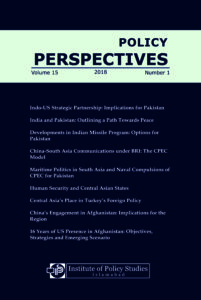 |
|
| Indo-US Strategic Partnership: Implications for Pakistan
Sadaf Farooq, Sadia Kazmi and Javaria Javed |
||
| India and Pakistan: Outlining a Path Towards Peace
Michael Hirsh, Ahmad Hassan Awan and |
||
| Developments in Indian Missile Program: Options for Pakistan
Shams-uz-Zaman |
||
| China-South Asia Communications under BRI The CPEC ModelKhalid Rahman |
||
| Maritime Politics in South Asia and Naval Compulsions of CPEC for Pakistan
Attiq-ur-Rehman |
||
| Human Security and Central Asian States
Saima A. Kayani |
||
| Central Asia’s Place in Turkey’s Foreign Policy
Zeeshan Fida |
||
| China’s Engagement in Afghanistan: Implications for the Region
Adam Saud and Azhar Ahmad |
||
|
Comment |
||
| 16 years of US Presence in Afghanistan Objectives, Strategies and Emerging ScenarioRahimullah Yusufzai |
||





